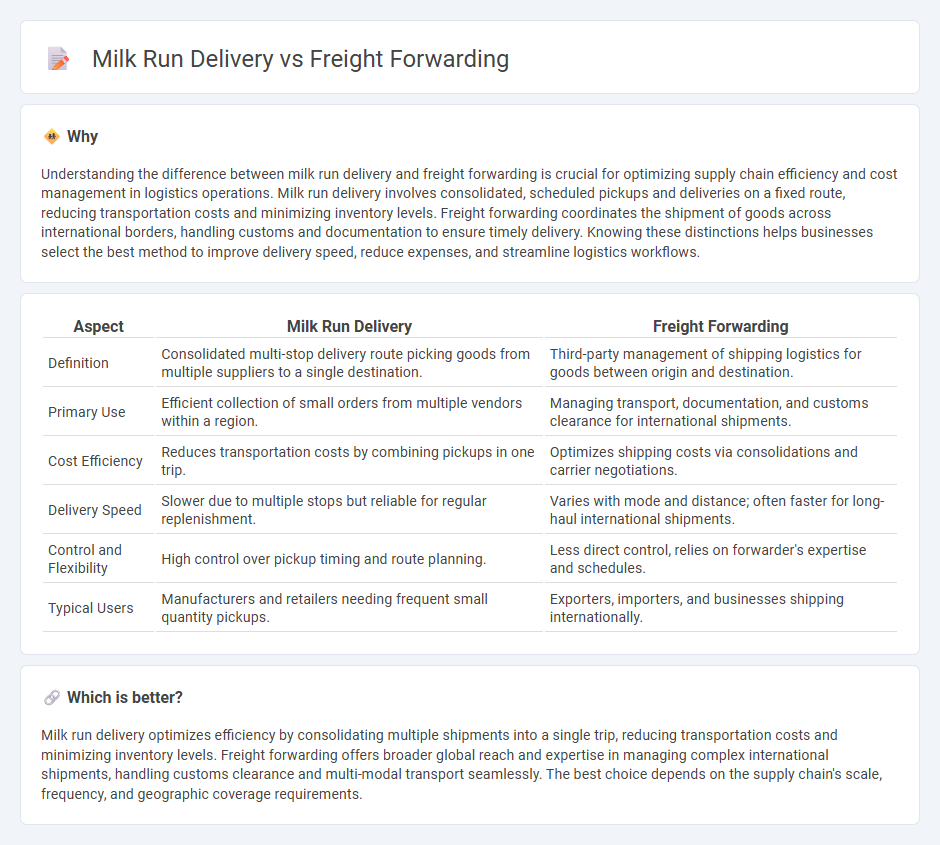
Milk run delivery optimizes supply chain efficiency by consolidating multiple shipments into a single route, reducing transportation costs and improving delivery times. Freight forwarding involves managing the logistics of shipping goods through various carriers and customs processes, focusing on global transportation solutions. Discover how choosing between milk run delivery and freight forwarding can streamline your logistics strategy.
Why it is important
Understanding the difference between milk run delivery and freight forwarding is crucial for optimizing supply chain efficiency and cost management in logistics operations. Milk run delivery involves consolidated, scheduled pickups and deliveries on a fixed route, reducing transportation costs and minimizing inventory levels. Freight forwarding coordinates the shipment of goods across international borders, handling customs and documentation to ensure timely delivery. Knowing these distinctions helps businesses select the best method to improve delivery speed, reduce expenses, and streamline logistics workflows.
Comparison Table
| Aspect | Milk Run Delivery | Freight Forwarding |
|---|---|---|
| Definition | Consolidated multi-stop delivery route picking goods from multiple suppliers to a single destination. | Third-party management of shipping logistics for goods between origin and destination. |
| Primary Use | Efficient collection of small orders from multiple vendors within a region. | Managing transport, documentation, and customs clearance for international shipments. |
| Cost Efficiency | Reduces transportation costs by combining pickups in one trip. | Optimizes shipping costs via consolidations and carrier negotiations. |
| Delivery Speed | Slower due to multiple stops but reliable for regular replenishment. | Varies with mode and distance; often faster for long-haul international shipments. |
| Control and Flexibility | High control over pickup timing and route planning. | Less direct control, relies on forwarder's expertise and schedules. |
| Typical Users | Manufacturers and retailers needing frequent small quantity pickups. | Exporters, importers, and businesses shipping internationally. |
Which is better?
Milk run delivery optimizes efficiency by consolidating multiple shipments into a single trip, reducing transportation costs and minimizing inventory levels. Freight forwarding offers broader global reach and expertise in managing complex international shipments, handling customs clearance and multi-modal transport seamlessly. The best choice depends on the supply chain's scale, frequency, and geographic coverage requirements.
Connection
Milk run delivery optimizes supply chain efficiency by consolidating multiple shipments into a single route, reducing transportation costs and improving delivery times. Freight forwarding manages the logistics of these consolidated shipments by coordinating transportation, customs clearance, and documentation across diverse carriers and locations. The integration of milk run delivery within freight forwarding enhances inventory management and ensures seamless movement of goods from suppliers to manufacturers or retailers.
Key Terms
Freight Forwarding:
Freight forwarding involves the coordination and shipment of goods from one location to another using multiple carriers and modes of transportation, ensuring efficient international logistics management. It includes services such as customs clearance, cargo insurance, and consolidation, making it ideal for businesses with complex supply chains and large volume shipments. Explore more to understand how freight forwarding can optimize your global shipping process.
Customs Clearance
Freight forwarding handles Customs Clearance by managing complex documentation and liaising with customs authorities to ensure smooth import and export processes across multiple shipments. Milk run delivery consolidates shipments from various suppliers into a single route, simplifying Customs Clearance by reducing the number of customs entries and optimizing inspection procedures. Explore how each method impacts your supply chain efficiency and regulatory compliance.
Bill of Lading
Freight forwarding involves the management of shipments through a Bill of Lading (B/L) that serves as a legal document, receipt, and contract between shipper and carrier, ensuring cargo accountability and transfer of ownership during international transport. Milk run delivery optimizes multiple pick-ups and deliveries under a consolidated Bill of Lading, reducing logistics costs and improving supply chain efficiency by minimizing transportation gaps. Explore detailed differences in Bill of Lading applications to enhance your understanding of freight forwarding and milk run logistics.
Source and External Links
What is freight forwarding? | Clarksons - Freight forwarding involves the strategic planning and coordination of international goods movement via air, sea, rail, and highway, with freight forwarders arranging transport logistics and customs handling on behalf of clients.
What Is Freight Forwarding? Definition, Benefits and Key Stages - Freight forwarders serve as intermediaries managing export haulage, customs clearance, origin checks, and shipping documentation to ensure legal, safe, and timely international delivery of goods.
About Freight Forwarding - FIATA - Freight forwarding facilitates international trade by managing carriage, consolidation, storage, customs, insurance, and supply chain logistics to deliver goods economically, timely, and in good condition.
 dowidth.com
dowidth.com